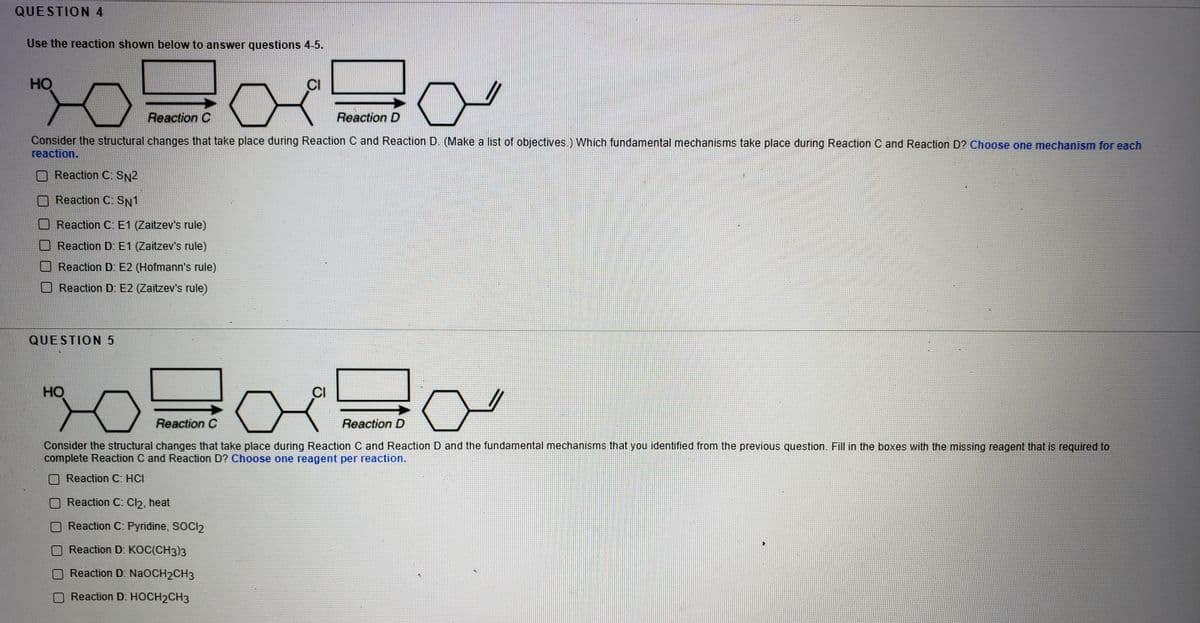QUESTION 4 Use the reaction shown below to answer questions 4-5. но Reaction C Reaction D Consider the structural changes that take place during Reaction C and Reaction D. (Make a list of objectives.) Which fundamental mechanisms take place during Reaction C and Reaction D? Choose one mechanism for each reaction. O Reaction C: SN2 O Reaction C: SN1 O Reaction C: E1 (Zaitzev's rule) O Reaction D: E1 (Zaitzev's rule) O Reaction D: E2 (Hofmann's rule) O Reaction D: E2 (Zaitzev's rule)
QUESTION 4 Use the reaction shown below to answer questions 4-5. но Reaction C Reaction D Consider the structural changes that take place during Reaction C and Reaction D. (Make a list of objectives.) Which fundamental mechanisms take place during Reaction C and Reaction D? Choose one mechanism for each reaction. O Reaction C: SN2 O Reaction C: SN1 O Reaction C: E1 (Zaitzev's rule) O Reaction D: E1 (Zaitzev's rule) O Reaction D: E2 (Hofmann's rule) O Reaction D: E2 (Zaitzev's rule)
Organic Chemistry: A Guided Inquiry
2nd Edition
ISBN:9780618974122
Author:Andrei Straumanis
Publisher:Andrei Straumanis
Chapter14: Elimination
Section: Chapter Questions
Problem 20E
Related questions
Question

Transcribed Image Text:QUESTION 4
Use the reaction shown below to answer questions 4-5.
HO
Reaction C
Reaction D
Consider the structural changes that take place during Reaction C and Reaction D. (Make a list of objectives.) Which fundamental mechanisms take place during Reaction C and Reaction D? Choose one mechanism for each
reaction.
Reaction C: SN2
Reaction C: SN1
Reaction C: E1 (Zaitzev's rule)
Reaction D: E1 (Zaitzev's rule)
Reaction D: E2 (Hofmann's rule)
Reaction D: E2 (Zaitzev's rule)
QUESTION 5
HO
CI
Reaction C
Reaction D
Consider the structural changes that take place during Reaction C and Reaction D and the fundamental mechanisms that you identified from the previous question. Fill in the boxes with the missing reagent that is required to
complete Reaction C and Reaction D? Choose one reagent per reaction.
Reaction C: HCI
Reaction C: Cl2, heat
OReaction C: Pyridine, SOCI2
Reaction D: KOC(CH3)3
OReaction D: NaOCH2CH3
OReaction D: HOCH2CH3
Expert Solution
This question has been solved!
Explore an expertly crafted, step-by-step solution for a thorough understanding of key concepts.
This is a popular solution!
Trending now
This is a popular solution!
Step by step
Solved in 2 steps with 1 images

Knowledge Booster
Learn more about
Need a deep-dive on the concept behind this application? Look no further. Learn more about this topic, chemistry and related others by exploring similar questions and additional content below.Recommended textbooks for you

Organic Chemistry: A Guided Inquiry
Chemistry
ISBN:
9780618974122
Author:
Andrei Straumanis
Publisher:
Cengage Learning

Organic Chemistry
Chemistry
ISBN:
9781305580350
Author:
William H. Brown, Brent L. Iverson, Eric Anslyn, Christopher S. Foote
Publisher:
Cengage Learning


Organic Chemistry: A Guided Inquiry
Chemistry
ISBN:
9780618974122
Author:
Andrei Straumanis
Publisher:
Cengage Learning

Organic Chemistry
Chemistry
ISBN:
9781305580350
Author:
William H. Brown, Brent L. Iverson, Eric Anslyn, Christopher S. Foote
Publisher:
Cengage Learning
